
Wine Culture and Information since 2002 - Volume 22
 Wine Culture and Information since 2002 - Volume 22 |
|
Issue 229, June 2023 |
Contents |
|
|
The Torments of Bordeaux |
|
There is no peace in the vineyards of Bordeaux. The vintners of the famous French wine land – among the most iconic in the world – are decidedly concerned and are making no secret of it. The French wine industry, to tell the truth, also the one of other countries, is going through a not exactly flourishing period, with significant drops in consumption and sales such as to arouse quite a concern among the producers of the country. Figures are saying the sales and export of French wines, especially those of Bordeaux, are registering a significant decline and not only as regards exports, but also for domestic consumption. The French – this is what the latest estimates seem to suggest – are strongly decreasing the per capita consumption of wine – in particular, the red one – with effects which seem to be significant for the entire wine industry. At the same time, the interest of the French for beer is growing, with consumption clearly increasing to the detriment of wine. Over the last few decades, the consumption of red wine in France has undergone a drastic drop, going from 120 liters per year in the 1940s to around 40 today. Estimates suggest a further decline for the next few years, forecasting an annual per capita consumption of red wine of just 25 liters. This time it is not because of the infamous effects of the recent Covid-19 pandemic, indeed to the new fads and social trends which favor a greater consumption of white and rosé wines. A decline that has brought its greatest effect, of course, in the territories historically and traditionally committed to the cultivation of red berried varieties, such as Bordeaux, of course. Estimates indicate a drop in the consumption of red wines of -32%, with a consequent economic loss of -6.2% due to lower sales. By way of comparison, the drop in sales volume that is affecting the sparkling wine production in France is just -0.5%. A decidedly significant difference. A loss which is having a considerable economic impact on the profits of Bordeaux wineries, so much so that it is starting a real crisis in the sector. For this reason, at the beginning of the year, the vintners of Bordeaux asked for the intervention of the French government in order to get an economic compensation deriving from the loss and which, it seems, are going to happen for the imminent future as well. Furthermore, the vintners have requested to uproot part of the vineyards, an unfortunate and disgraceful operation which not only deprives the environment of the beauty of its vineyards, but also the inevitable loss of profits. After all, if the wine from those vineyards cannot be sold, the only thing left to do is, so to speak, act accordingly and limit future losses. It is a known fact that maintaining and cultivating a vineyard, harvesting its grapes and transforming them into wine has a cost that is not exactly trivial in the budget of any winery. The estimates and requests suggest a frightening quota of 15,000 hectares of excess vineyards, therefore to be uprooted, equal to about 10% of the total area destined for the cultivation of vineyards in the whole territory of Bordeaux. Unfortunately, this is not the only problem afflicting the Bordeaux wine industry. If the uprooting of vineyards limits the future production, there is still the problem of the destination or use of the red wine currently produced and which will probably remain unsold. Due to this specific condition, the French government has approved the distillation of the excess quotas for 2023, foreseeing a cost of approximately 160 million euros for the operation. In this regard, it should be noted France had already adopted a similar measure in recent times and, precisely, in 2020. On that occasion, because of the drastic drop in consumption resulting from the effect of the Covid-19 pandemic, the French government had approved the distillation of excess wine. Unfortunately, the torments of the Bordeaux vintners do not end there. Indeed, the vineyards of the iconic French wine-growing area are suffering the effects of flavescence dorée, a disease endemic in Europe and with a high spreading capacity. The French government, accepting the requests of the Bordeaux winegrowers – also to limit the harmful effects of flavescence dorée – has approved the uprooting of 9,500 hectares of vineyards and allocated 57 million euros for compensation, destined to the winegrowers who will join the campaign. The possibility of uprooting is granted – upon request – to the owners and managers of vineyards in the Gironde area, recognizing them a compensation of € 6,000 for each hectare. Those who adhere to the possibility of uprooting vineyards need to prove that the vines (therefore, not the vineyard) have been in production in the last 5 years and until 2022. Furthermore, it will be necessary to declare the purpose of the uprooting and the future destination of the area where the vineyard is located. Vintners seems to be pushing for a quick and decisive procedure, as they are convinced that the faster it will be done, the better it will be for everyone. The idea of uprooting is certainly dramatic and painful, however it is the premise for limiting future losses, in particular by considering the progressive decline in the consumption of red wine and the possible spreading of flavescence dorée. As for the drop in domestic consumption and related to red wines, according to a survey carried out in 2022, the causes would be to be found in the new social trends and habits of the French, a condition that could also extend to the rest of Europe. According to the results of this survey, the drop in the consumption of red wines is due to the concomitant reduction in the consumption of red meat, food for which – notoriously – red wine is preferably paired. Other causes would be to be found in the current preferences of consumers in preferring wines with a lower alcohol volume and, more specifically, wines suitable for aperitifs, such as whites and sparkling wines, which generally have a lower alcohol volume. According to the same survey, another factor which has determined the drop in the consumption of red wines is linked to the decreasing tendency of families to consume meals together in addition to the growing number of single-parent families, in which the only adult chooses not to uncork a bottle of wine – especially, red and robust – to accompany the meal. As for the Bordeaux vineyard uprooting campaign, the operation should begin next October and will literally see almost 10% of the vineyards in the area disappear. In this regard, it must be said the majority of these vineyards belong to small and medium-sized wineries, that is the category that has most suffered the severe consequences of the drop in consumption and exports. In fact, to face these losses, small producers were forced to sell off their wine at very low prices, generating a huge loss. A condition that – it must be said – does not concern the big and famous Châteaus of Bordeaux, for which the crisis has not had significant effects, so much so that many of them continue to expand their lands and buy new vineyards. A two-faced crisis, therefore, in which – as always and everywhere it happens – it is the smallest who suffer the worst consequences, with the real risk of disappearing, overwhelmed by higher costs and fewer market opportunities. Maybe it is simply the effect of a passing fad – like the so many we have witnessed in recent decades – with the fluctuating preferences of consumers who, cyclically, prefer a certain style of wine while penalizing the others. Fads have an easy hold on the community: today red wines – also from Bordeaux – have few reasons to smile, while whites, rosés and sparkling wines have good reasons to celebrate. At least until the glasses will return, surely and sooner or later, to turn red again. Antonello Biancalana
|
||||
Contrasts of Cannonau di Sardegna Rosato and Cerasuolo d'Abruzzo SuperioreTwo magnificent red grapes in the rosé interpretation and expression of wines produced in two important wine regions of Italy, mainly known for their whites and reds. |
|
From red berried grapes can be produced not only red wines. With these grapes – as it is well known – can also be produced rosé wines, making use of specific wine making techniques and which, of course, are not used for the production of red wines. In this regard – should there be the need to clarify this aspect – in accordance with the laws in force, the production of rosé wines from the blending of whites and reds is not permitted, except for base wines to be used for the production of rosé sparkling wines. In this specific case, it must however be noted that a rosé sparkling wine is not always the result of the blending of white and red wines, as it is possible to produce it also by starting from a rosé wine, that is exclusively produced with red berried grapes. The enological factor discriminating between a rosé and red wine is notoriously represented by the maceration time of the must with the skins, in which the coloring power of the red berried grapes is contained. It is about decidedly short maceration times, which can vary from a very few hours, rarely beyond twenty. The longer the maceration time, the greater the quantity of coloring substances released from the skins into the must, therefore the more intense the color which will progressively tend from pale pink to red. Finally, it should be noted the production of rosé wines also includes the technique of bleeding – or saignée, as the French say – which consists in taking a fraction of the must in preliminary maceration with skins and intended for the production of a red wine. What is obtained is, in fact, a rosé must which, at the end of fermentation, will become wine. The enological scenario of Italy offers a wide selection of rose wines, a style of wine which in recent years has been attracting good interest from consumers. There are in fact many wine territories in Italy which include rose wines in their production disciplinaries, exactly like the ones we are examining for our tasting by contrast. We will in fact pour into our glasses two rosés belonging to important and renowned denominations: Cannonau di Sardegna Rosato and Cerasuolo d'Abruzzo Superiore.
|
|
When it is about Sardinian wines, one of the first grapes which is most easily associated to the region undeniably is Cannonau. This magnificent variety is widespread throughout the Sardinian territory, and it certainly is the most famous and celebrated one for the island's reds. The wines produced with this grape – in fact –- are recognized by the Italian quality system as Denominazione d'Origine Controllata Cannonau di Sardegna (Denomination of Controlled Origin, DOC). The disciplinary provides for the production of wines in different styles, among these, also rosé, that is the wine we will examine in the tasting by contrast of this month. A style which in recent years has been attracting good interest from producers and, last but not least, from consumers, also due to the greater market demand for this specific style of wine. The production disciplinary of Cannonau di Sardegna, also for the rosé style, provides for the minimum use of 85% of the variety of the same name, while any complementary part can be composed of non-aromatic red berried grapes allowed for cultivation in Sardinia. It is a well known fact Cannonau corresponds to Grenache Noir, or rather, to the Garnacha known in Spain. This variety, in addition to Sardinia, Spain and France, is also found in other wine areas of the world, including various regions of Italy. This analogy has long led to the supposition of the Spanish origin of Cannonau, supporting the hypothesis that it had been introduced to the island in 1400s by the Spaniards. This hypothesis has been denied by some archaeological discoveries conducted in Sardinia, which have allowed the discovery of Cannonau seeds dating back to 3200 years ago. This extraordinary discovery has therefore made it possible to identify Cannonau as a native variety of Sardinia, thus suggesting the reverse journey, that is introduced in Spain and France from this island. This proves, not least, the very long bond of the ancient peoples of Sardinia with viticulture and enology, evidently consolidated and perpetuated up to the present day.
|
||||
|
The enology of Abruzzo is firmly linked to two varieties: Trebbiano d'Abruzzo for the whites, Montepulciano for the reds and, of course, rosés. In fact, when one thinks of the wines of this region, the association with these two grapes and related wines is practically inevitable. Both varieties are the basis of the main and historical Denominazione d'Origine Controllata wines of the region: Trebbiano d'Abruzzo and Montepulciano d'Abruzzo. To these we must add Cerasuolo which, until a few years ago, was in fact included in the production disciplinary of the great red wine of the region, whereas today it is properly recognized with its own denomination. At the basis of this historic rosé wine from Abruzzo, we find the Montepulciano variety, which must be present – according to the production disciplinary – for a minimum of 85%. The remaining part, as often happens for almost all Italian DOC wines, is possibly made up of non-aromatic red berried grapes and permitted for cultivation in the region. The production disciplinary of this wine also provides for the superiore style – and this is what we examine in our tasting – which is characterized by the higher alcohol content and the possibility of aging in wooden containers. Cerasuolo d'Abruzzo certainly is among the most famous rosé wines of Italy and has a long tradition, without a shadow of a doubt among the most versatile rosés in food and wine pairing. Thanks to the Montepulciano grape, Cerasuolo d'Abruzzo can express singular and different characters, from light and immediate wines, to structured and robust interpretations. To this must also be added the possibility of aging in wood for the “superiore” style which, when used, gives Cerasuolo d'Abruzzo organoleptic power and complexity. In this regard, it should be noted the aging of this wine in wood is pretty rare and the majority of producers prefer the use of inert containers, in order to better enhance the crispness and immediacy of the wine.
|
Let's proceed with getting the two bottles we will pour into the glasses for our tasting by contrast. At this time, it is about two wines which are very common, therefore it will not be difficult to find them in any good wine shop. For both wines, we need to be careful in choosing bottles which have been produced with the respective varietals alone. This aspect is very important as the production disciplinary of Cannonau di Sardegna Rosato and Cerasuolo d'Abruzzo Superiore allow the use of at least 85% of the primary variety. As far as wine making practices are concerned, we will make sure the two wines have been fermented and aged in inert containers, preferably steel tanks. This allows, in fact, to better appreciate the qualities of the two grapes and, in particular, the crispness of the rosés. The two wines belong to the most recent vintage and are poured into their respective glasses at a temperature of 12 °C. (54 °F) The first sensorial characteristic we will examine is appearance, therefore how wines are seen by our eyes in terms of color and transparency. Let's start by observing the glass of Cannonau di Sardegna Rosato and – by tilting the glass over a white surface – let's pay attention to the base, where the thickness of the wine is greatest. It can be observed a cherry pink color of medium intensity and transparency – evaluated by placing an object in contrast between the white surface and the glass – is decidedly high. Let's now proceed with the evaluation of nuances, therefore let's pay attention to the opening of the glass, where the wine becomes thin. The nuance of Cannonau di Sardegna Rosato confirms its base color. Let's move on to the evaluation of the appearance of Cerasuolo d'Abruzzo Superiore, starting from color and transparency. By observing the wine at the base of the glass, we notice a decidedly intense cherry pink color, generally much more than the Sardinian wine, with a high transparency, however lower than that of the previous wine. The nuance of Cerasuolo d'Abruzzo Superiore confirms the base color. The olfactory profiles of Cannonau and Montepulciano are extremely different, not only when comparing their interpretations of red wines. These differences are also evident in rosé vinifications, for which the maceration time with the skins becomes a further discriminating factor. In this regard, it should however be noted the olfactory differences between Cannonau and Montepulciano are decidedly more evident and distant especially in red wines, whereas in rosé ones they become more subtle and less varied. In both cases, in their interpretations in rosé, are mainly perceived aromas of flowers with pink or red petals – such as cyclamen and rose – however in those produced with Montepulciano it is not uncommon to perceive violet as well. The world of fruits of Cannonau and Montepulciano vinified in rosé is strongly characterized by red pulp fruits, often also dark, which are sometimes combined with peach and pleasing hints of citrus fruits, in particular tangerine. Let's continue this month's tasting by contrast and proceed with the analysis of the olfactory profiles of Cannonau di Sardegna Rosato and Cerasuolo d'Abruzzo Superiore, starting – as in the previous phase – from the Sardinian wine. Let's hold the glass in vertical position and, without swirling, do the first smell in order to appreciate the opening of the wine, that is the evaluation of its primary and identifying aromas. From the glass are perceived clean and pleasing notes of cyclamen followed by aromas of cherry, raspberry and strawberry. Let's now swirl the glass and proceed with the second smell, therefore evaluating the remaining aromas of the wine. From the glass we can now appreciate aromas of rose, blueberry, plum and hints of peach. Let's move on to the evaluation of the olfactory profile of Cerasuolo d'Abruzzo Superiore, therefore by holding the glass in vertical position, let's proceed with the analysis of the opening. The nose perceives intense and clean aromas of cyclamen followed by cherry, blueberry and raspberry. After having swirled the glass and carried out the second smell, the olfactory profile of the wine from Abruzzo is completed with dog rose and violet as well as fruit aromas in which we recognize blackberry, plum and pomegranate, often followed by tangerine. Finally, in this wine, it can sometimes be perceived aromas of almond. Let's now pass to the evaluation of the gustatory profiles of the wines of our tasting by contrast and – as in the previous phases – let's start with the Cannonau di Sardegna Rosato. Let's therefore take a sip of this wine in order to evaluate its attack, that is the initial and identifying gustatory sensations. The first sensation we perceive in the mouth is the crispness given by acidity and which finds its balance in the effect of alcohol. It can also be perceived a slight sensation of astringency and a medium body structure. In the mouth are clearly perceived the flavors of cherry, raspberry and strawberry, therefore confirming a good correspondence to the nose. Let's move on to the evaluation of the attack of Cerasuolo d'Abruzzo Superiore, take a sip and focus on the sensations perceived in the mouth. The wine from Abruzzo can be appreciated for its pleasing crispness which is often combined with a good alcohol volume – useful for reaching balance – as well as the sensation of good structure, generally fuller than Cannonau di Sardegna Rosato. In this wine can also be appreciated a slight astringency, as well as flavors of cherry, raspberry and blueberry,therefore having a good correspondence to the nose. We have reached the end of this month's tasting by contrast, therefore let's proceed with the evaluation of the final sensations the two wines leave in the mouth after swallowing, in particular the taste-olfactory persistence. The finish of Cannonau di Sardegna Rosato is persistent and in the mouth are still perceived both the pleasing crispness given by acidity and the pseudo-burning effect of alcohol, well supported by the good structure. We can also clearly perceive the flavors of cherry, raspberry and strawberry. The finish of Cerasuolo d'Abruzzo Superiore is certainly persistent and, also in this case, the crispness given by acidity is clearly perceived as well as the pseudo-burning sensation produced by the alcohol which, in the superiore style, plays a determinant role. The sensation of structure is decidedly well perceptible and generally fuller than Cannonau di Sardegna Rosato. In the mouth we also continue to perceive the flavors of cherry, raspberry and blueberry, frequently followed by blackberry. Before concluding the tasting, let's do a final analysis of the olfactory profiles, first the Cannonau di Sardegna Rosato and then the Cerasuolo d'Abruzzo Superiore: the differences are still well distinct and evident.
|
||||||||
Wines of the Month |
|
|
|
Score legend Prices are to be considered as indicative. Prices may vary according to the country or the shop where wines are bought |
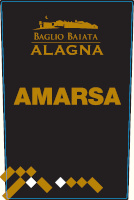
|
|
Amarsa |
|
| Alagna (Sicily, Italy) | |
 Grillo, Catarratto, Inzolia Grillo, Catarratto, Inzolia | |
| Price: € 12.50 | Score: |
 Intense mahogany and nuances of mahogany, little transparency. Intense mahogany and nuances of mahogany, little transparency. Intense, clean, pleasing and refined, starts with hints of citrus fruit
peel and gentian followed by aromas of orange, caramel, vanilla and almond. Intense, clean, pleasing and refined, starts with hints of citrus fruit
peel and gentian followed by aromas of orange, caramel, vanilla and almond.
 Sweet and round attack, however balanced by alcohol, good body, intense
flavors, pleasing bitter touch. Sweet and round attack, however balanced by alcohol, good body, intense
flavors, pleasing bitter touch.
 Persistent finish with flavors of gentian, orange and caramel. Persistent finish with flavors of gentian, orange and caramel. Produced with Marsala Fine and added flavoring. Produced with Marsala Fine and added flavoring. |
|
 Dried fruit tarts, Confectionery Dried fruit tarts, Confectionery |
|
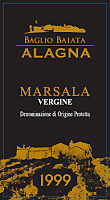
|
|
Marsala Vergine Baglio Baiata 1999 |
|
| Alagna (Sicily, Italy) | |
 Grillo, Catarratto Grillo, Catarratto | |
| Price: € 26.50 | Score: |
 Intense amber yellow and nuances of amber yellow, moderate
transparency. Intense amber yellow and nuances of amber yellow, moderate
transparency.
 Intense, clean, pleasing and refined, starts with hints of rancho,
dried fig and citrus fruit peel followed by aromas of date, hazelnut,
honey, almond, licorice, leather and vanilla. Intense, clean, pleasing and refined, starts with hints of rancho,
dried fig and citrus fruit peel followed by aromas of date, hazelnut,
honey, almond, licorice, leather and vanilla.
 Crisp attack and however balanced by alcohol, full body, intense
flavors, pleasing roundness. Crisp attack and however balanced by alcohol, full body, intense
flavors, pleasing roundness.
 Persistent finish with flavors of dried fig, hazelnut and honey. Persistent finish with flavors of dried fig, hazelnut and honey. Aged in cask. Aged in cask. |
|
 Aperitifs, Hard and piquant cheese Aperitifs, Hard and piquant cheese |
|
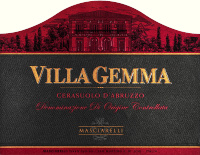
|
|
Cerasuolo d'Abruzzo Superiore Villa Gemma 2021 |
|
| Masciarelli (Abruzzo, Italy) | |
 Montepulciano Montepulciano | |
| Price: € 15.10 | Score: |
 Intense cherry pink and nuances of cherry pink, moderate transparency. Intense cherry pink and nuances of cherry pink, moderate transparency. Intense, clean, pleasing, refined and elegant, starts with hints of
cherry, raspberry and rose followed by aromas of cyclamen, strawberry,
pomegranate, blueberry, blackberry, plum, apple and peach. Intense, clean, pleasing, refined and elegant, starts with hints of
cherry, raspberry and rose followed by aromas of cyclamen, strawberry,
pomegranate, blueberry, blackberry, plum, apple and peach.
 Crisp attack and however balanced by alcohol, good body, intense
flavors, agreeable. Crisp attack and however balanced by alcohol, good body, intense
flavors, agreeable.
 Persistent finish with flavors of cherry, raspberry and strawberry. Persistent finish with flavors of cherry, raspberry and strawberry. 3 months in steel tanks. 3 months in steel tanks. |
|
 Pasta with meat, Roasted fish, Broiled fish, Roasted white meat, Dairy products, Legume soups Pasta with meat, Roasted fish, Broiled fish, Roasted white meat, Dairy products, Legume soups |
|
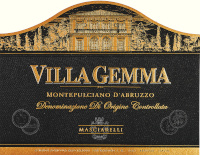
|
|
Montepulciano d'Abruzzo Riserva Villa Gemma 2017 |
|
| Masciarelli (Abruzzo, Italy) | |
 Montepulciano Montepulciano | |
| Price: € 61.00 | Score: |
 Deep ruby red and nuances of garnet red, impenetrable to light. Deep ruby red and nuances of garnet red, impenetrable to light. Intense, clean, pleasing, refined and elegant, starts with hints fo
plum, black cherry and blueberry followed by aromas of dried violet, peony,
blackberry, cocoa, carob, tobacco, cinnamon, licorice, leather, mace,
graphite, vanilla and menthol. Intense, clean, pleasing, refined and elegant, starts with hints fo
plum, black cherry and blueberry followed by aromas of dried violet, peony,
blackberry, cocoa, carob, tobacco, cinnamon, licorice, leather, mace,
graphite, vanilla and menthol.
 Properly tannic attack and however balanced by alcohol, full body,
intense flavors, pleasing roundness. Properly tannic attack and however balanced by alcohol, full body,
intense flavors, pleasing roundness.
 Very persistent finish with long flavors of plum, black cherry and
blueberry. Very persistent finish with long flavors of plum, black cherry and
blueberry.
 18 months in barrique, at least 24 months in bottle. 18 months in barrique, at least 24 months in bottle. |
|
 Game, Roasted meat, Stewed and braised meat, Hard cheese Game, Roasted meat, Stewed and braised meat, Hard cheese |
|
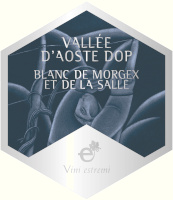
|
|
Valle d'Aosta Blanc de Morgex et de La Salle Vini Estremi 2021 |
|
| Cave Mont Blanc de Morgex et La Salle (Vallée d'Aoste, Italy) | |
 Prié Blanc Prié Blanc | |
| Price: € 15.00 | Score: |
 Brilliant greenish yellow and nuances of greenish yellow, very
transparent. Brilliant greenish yellow and nuances of greenish yellow, very
transparent.
 Intense, clean, pleasing and refined, starts with hints of peach, pear
and pineapple followed by aromas of wisteria, broom, hawthorn, lemon, green
apple, kiwi, almond and mineral. Intense, clean, pleasing and refined, starts with hints of peach, pear
and pineapple followed by aromas of wisteria, broom, hawthorn, lemon, green
apple, kiwi, almond and mineral.
 Crisp attack and however balanced by alcohol, light body, intense
flavors, agreeable. Crisp attack and however balanced by alcohol, light body, intense
flavors, agreeable.
 Persistent finish with flavors of peach, pineapple and lemon. Persistent finish with flavors of peach, pineapple and lemon. Aged in steel tanks. Aged in steel tanks. |
|
 Vegetable and crustacean appetizers, Risotto with vegetables and crustaceans, Sauteed crustaceans, Eggs Vegetable and crustacean appetizers, Risotto with vegetables and crustaceans, Sauteed crustaceans, Eggs |
|
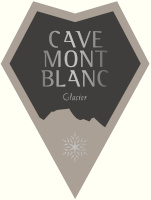
|
|
Valle d'Aosta Blanc de Morgex et de La Salle Metodo Classico Pas Dosé Glacier 2019 |
|
| Cave Mont Blanc de Morgex et La Salle (Vallée d'Aoste, Italy) | |
 Prié Blanc Prié Blanc | |
| Price: € 24.00 | Score: |
 Brilliant straw yellow and nuances of straw yellow, very transparent. Brilliant straw yellow and nuances of straw yellow, very transparent. Intense, clean, pleasing and refined, starts with hints of green apple,
citrus fruits and bread crust followed by aromas of hawthorn, wisteria,
jasmine, pear, kiwi, peach, mineral and hints of vanilla. Intense, clean, pleasing and refined, starts with hints of green apple,
citrus fruits and bread crust followed by aromas of hawthorn, wisteria,
jasmine, pear, kiwi, peach, mineral and hints of vanilla.
 Crisp and effervescent attack, however balanced by alcohol, good body,
intense flavors, agreeable. Crisp and effervescent attack, however balanced by alcohol, good body,
intense flavors, agreeable.
 Persistent finish with flavors of green apple, pear and kiwi. Persistent finish with flavors of green apple, pear and kiwi. The base wine ferments part in cask and part in steel tanks.
Refermented in bottle and aged on its lees for at least 24 months. The base wine ferments part in cask and part in steel tanks.
Refermented in bottle and aged on its lees for at least 24 months.
|
|
 Pasta and risotto with fish and crustaceans, Sauteed fish, Broiled crustaceans, Dairy products Pasta and risotto with fish and crustaceans, Sauteed fish, Broiled crustaceans, Dairy products |
|
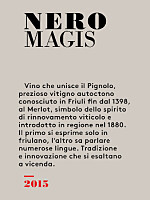
|
|
Friuli Colli Orientali Rosso Nero Magis 2015 |
|
| Magis (Friuli-Venezia Giulia, Italy) | |
 Merlot (60%), Pignolo (40%) Merlot (60%), Pignolo (40%) | |
| Price: € 35.90 | Score: |
 Intense ruby red and nuances of garnet red, little transparency. Intense ruby red and nuances of garnet red, little transparency. Intense, clean, pleasing, refined and elegant, starts with hints of
black currant, black cherry and plum followed by aromas of violet, peony,
blueberry, cocoa, tobacco, sandal wood, licorice, leather, mace, vanilla
and eucalyptus. Intense, clean, pleasing, refined and elegant, starts with hints of
black currant, black cherry and plum followed by aromas of violet, peony,
blueberry, cocoa, tobacco, sandal wood, licorice, leather, mace, vanilla
and eucalyptus.
 Properly tannic attack and however balanced by alcohol, good body,
intense flavors, agreeable. Properly tannic attack and however balanced by alcohol, good body,
intense flavors, agreeable.
 Very persistent finish with long flavors of black currant, black cherry
and plum. Very persistent finish with long flavors of black currant, black cherry
and plum.
 24 months in bottle. 24 months in bottle. |
|
 Roasted meat, Stewed meat with mushrooms, Broiled meat and barbecue, Cheese Roasted meat, Stewed meat with mushrooms, Broiled meat and barbecue, Cheese |
|
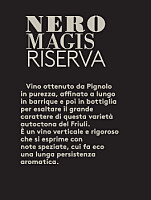
|
|
Friuli Colli Orientali Rosso Riserva Nero Magis 2016 |
|
| Magis (Friuli-Venezia Giulia, Italy) | |
 Pignolo Pignolo | |
| Price: € 49.00 | Score: |
 Deep ruby red and and nuances of garnet red, little transparency. Deep ruby red and and nuances of garnet red, little transparency. Intense, clean, pleasing, refined and elegant, starts with hints of
black cherry, plum and dried violet followed by aromas of peony,
blackberry, blueberry, cocoa, tobacco, lavender, cinnamon, face powder,
licorice, leather, mace, vanilla and menthol. Intense, clean, pleasing, refined and elegant, starts with hints of
black cherry, plum and dried violet followed by aromas of peony,
blackberry, blueberry, cocoa, tobacco, lavender, cinnamon, face powder,
licorice, leather, mace, vanilla and menthol.
 Properly tannic attack and however balanced by alcohol, full body,
intense flavors, pleasing crispness. Properly tannic attack and however balanced by alcohol, full body,
intense flavors, pleasing crispness.
 Very persistent finish with long flavors of plum, black cherry and
blackberry. Very persistent finish with long flavors of plum, black cherry and
blackberry.
 At least 24 months in barrique, at least 18 months in bottle. At least 24 months in barrique, at least 18 months in bottle. |
|
 Game, Stewed and braised meat with mushrooms, Roasted meat, Hard cheese Game, Stewed and braised meat with mushrooms, Roasted meat, Hard cheese |
|
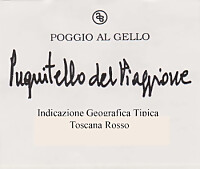
|
|
Pugnitello del Piaggione 2020 |
|
| Poggio al Gello (Tuscany, Italy) | |
 Pugnitello Pugnitello | |
| Price: € 22.00 | Score: |
 Intense ruby red and nuances of ruby red, little transparency. Intense ruby red and nuances of ruby red, little transparency. Intense, clean, pleasing and refined, starts with hints of black
cherry, black currant and plum followed by aromas of violet, blueberry,
blackberry, chocolate, black pepper, graphite and vanilla. Intense, clean, pleasing and refined, starts with hints of black
cherry, black currant and plum followed by aromas of violet, blueberry,
blackberry, chocolate, black pepper, graphite and vanilla.
 Properly tannic attack and however balanced by alcohol, good body,
intense flavors, agreeable. Properly tannic attack and however balanced by alcohol, good body,
intense flavors, agreeable.
 Persistent finish with flavors of black cherry, black currant and plum. Persistent finish with flavors of black cherry, black currant and plum. 12 months in barrique, 6 months in bottle. 12 months in barrique, 6 months in bottle. |
|
 Broiled meat and barbecue, Roasted meat, Stewed meat with mushrooms, Cheese Broiled meat and barbecue, Roasted meat, Stewed meat with mushrooms, Cheese |
|
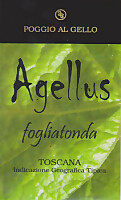
|
|
Agellus 2018 |
|
| Poggio al Gello (Tuscany, Italy) | |
 Foglia Tonda Foglia Tonda | |
| Price: € 25.00 | Score: |
 Intense ruby red and nuances of garnet red, little transparency. Intense ruby red and nuances of garnet red, little transparency. Intense, clean, pleasing, refined and elegant, starts with hints of
plum, black cherry and blackberry followed by aromas of dried violet,
blueberry, carob, cocoa, tobacco, licorice, leather, graphite, vanilla and
menthol. Intense, clean, pleasing, refined and elegant, starts with hints of
plum, black cherry and blackberry followed by aromas of dried violet,
blueberry, carob, cocoa, tobacco, licorice, leather, graphite, vanilla and
menthol.
 Properly tannic attack and however balanced by alcohol, good body,
intense flavors, pleasing roundness. Properly tannic attack and however balanced by alcohol, good body,
intense flavors, pleasing roundness.
 Persistent finish with flavors of plum, black cherry and blackberry. Persistent finish with flavors of plum, black cherry and blackberry. 12 months in barrique, 6 months in bottle. 12 months in barrique, 6 months in bottle. |
|
 Broiled meat and barbecue, Stewed meat with mushrooms, Roasted meat, Cheese Broiled meat and barbecue, Stewed meat with mushrooms, Roasted meat, Cheese |
|
News |
|
In this section are published news and information about events concerning the world of wine and food. Whoever is interested in publishing this kind of information can send us a mail to our address.
|
AquavitaeReview of Grappa, Distillates and Brandy |
|
|
||||||||||||
Wine Guide ParadeMarch 2023
|
| |||||||
Privacy Policy | |||||||


| Copyright © 2002-2024 Antonello Biancalana, DiWineTaste - All rights reserved |
| All rights reserved under international copyright conventions. No part of this publication and of this WEB site may be
reproduced or utilized in any form or by any means, electronic or mechanical, without permission in writing from DiWineTaste. |